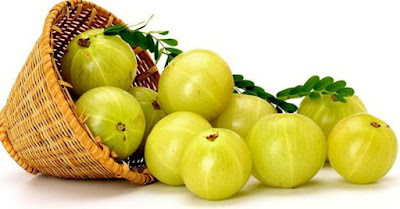Nellikai/Amla (Indian Gooseberry) a Medicinal Fruit

Gooseberries are nutritious, low-calorie fruits that are rich in vitamins, minerals, and antioxidants. Though research on gooseberries specifically is limited, many of the nutrients in these berries have been linked to significant health benefits.
These
include lower blood sugar, cholesterol, and blood pressure levels, as well as a
reduced risk of cancer, diabetes, heart disease, and age-related illnesses of
the brain. Gooseberries are a wonderful,
healthy fruit to include in your diet as a snack or flavorful addition to
meals.
Gooseberries are is low in calories and
fat, yet packed with
nutrients, but rich in dietary fiber, copper,
manganese, potassium, and vitamins C, B5, and B6.

Just 1 cup (150 grams) of gooseberries contains:
- Calories: 66
- Protein: 1
gram
- Fat: less
than 1 gram
- Carbs: 15
grams
- Fiber: 7
grams
- Copper: 12%
of the DV (Daily Value)
- Manganese: 9%
of the DV
- Potassium: 6%
of the DV
- Vitamin B5: 9%
of the DV
- Vitamin B6: 7%
of the DV
- Vitamin C: 46%
of the DV
Vitamin C is a powerful antioxidant and vital to your nervous
systems, immune system,
and for the skin. Vitamin B5 is necessary for creating fatty acids, while vitamin
B6, which many enzymes and cells in your body need to function, helps convert
food into energy.
1.
Gooseberries are low in calories and fat but
rich in dietary fiber, copper, manganese, potassium, and vitamins C, B5, and B6.
2.
Gooseberries are low in calories and high in
fiber, which helps protect against obesity, heart disease, type 2 diabetes, and
some types of cancer.
3.
Gooseberries are rich in antioxidants, such
as phytonutrients, and vitamins E and C, which may help protect your brain and
fight aging.
4.
Gooseberries are high in fiber and
chlorogenic acid, which may help slow or prevent the absorption of sugar into
your bloodstream.
5.
Gooseberries are rich in citric acid,
phenols, and antioxidants, which are linked to a reduced risk of age-related brain
diseases, such as Alzheimer’s and stroke.
6.
Gooseberries are rich in antioxidants and
polyphenols, such as anthocyanins, that may fight and reduce your risk of
certain types of cancer.
7.
Gooseberries contain heart-healthy
antioxidants, polyphenols, and potassium, which help keep your heart working
properly and may reduce your risk of heart disease.
8.
Gooseberries are best enjoyed fresh and can
be eaten on their own. Cooked gooseberries may not have the same health
benefits, as some of the nutrients will be destroyed.
9.
Gooseberries
are excellent for maintaining healthy hair, boosting eyesight, and ensuring
smooth digestion.
10. Gooseberries are considered great for maintaining lustrous, healthy clear, and smooth skin.
Ayurveda heavily depends on the use of plants and herbs for their medicinal properties. It paved the way for a few items to become an integral part of our daily diet. Amla or Indian Gooseberry is one such ingredient that has long been hailed for its health-benefiting properties.
In South India, the fruit is used in preparing dal (lentil preparation)
and often added to rice as well. It can also help balance all three doshas (Vata/Pitta/Kapha) in the body and treat the
underlying cause of many health problems.
Amla is one of the primary ingredients that go into the making of an ancient Ayurvedic polyherbal the concoction is popularly known as chyawanprash.
Some dishes
1. Mavinakayi Nellikai Chitranna (Raw Mango & Gooseberry Rice)
An interesting and tangy
combination of amla and
raw mangoes render a unique flavor to the rice. Follow in a few simple steps to
serve this culinary gem straight from the heart of South India.
2. Amla Murabba
Sweet can be healthy when it is done with gooseberries! Boiled
amla pieces are doused in sugar syrup and flavored with cardamom. Prepare it in
the winter months and make the most of it.
3. Amla Chutney
Amla along with fennel, brahmi leaves, and other spices give you
a lip-smacking blend of flavors that will team well with almost anything. You
can pair this chutney with any type of parathas to make the culinary experience
even more delightful.
4. Amla Pickle (Nelika Urugai)
Six basic ingredients, few days, few hassle-free steps will get
you this piquant, flavorful urugai. This urugai recipe is quite flavorful and
goes best with almost anything. It goes very well with curd rice most south Indians
favorite.
5. Amla Juice
After boiling and deseeding amla, with some water and honey in a
blender, make it into a thick juice. Strain and take it on an empty stomach for
better health.


Comments
Post a Comment